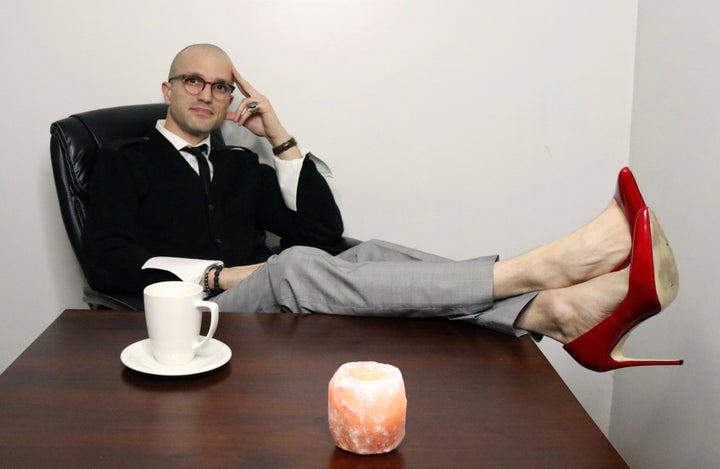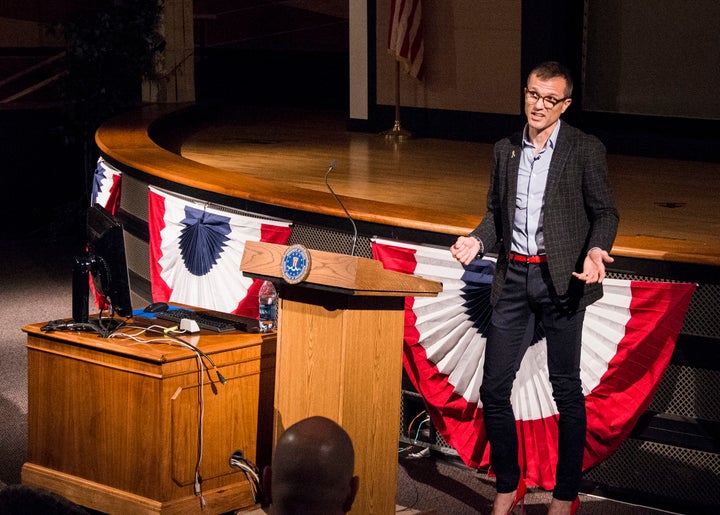
When you present as a man and you’re a soldier, and you slip into a pair of high heels before walking into an imposing building at Patrick Air Force Base, Florida ― filled with other soldiers, sailors, airmen, Marines and federal civilian employees from all branches of the armed forces ― you’re bound to turn some heads.
That particular day was one of the most gut-wrenching I’ve ever experienced in the military, and I don’t say that lightly. I’ve been in the Army Reserve components for more than 17 years, including my first mobilization on Sept. 11, 2001, and two subsequent combat zone deployments that put me in the Middle East for 22 months.
Still, not much compared to my feelings before I showed up to training in high heels. It was just one of 26 days of an intensive course that would certify participants as equal opportunity practitioners and mediators for the Department of Defense. The training had about 100 participants, with many activities facilitated in small groups of about 10-12 service members.
Our instructors gave us the option of wearing civilian clothes instead of uniforms that day as part of a team-building event. I decided I wanted to put myself out there and facilitate some needed dialogue about gender identity, so I went high heel-shopping for the occasion.
Up to that point, I’d never even considered the labels “genderqueer” or “gender fluid” ― meaning a person doesn’t understand their gender as neatly fitting into binary notions of male or female ― to describe myself. I had come out as a gay man a decade prior, but sexual orientation and gender identity are two completely different things, sexual orientation being who one is attracted to, and gender identity being one’s internal sense of their own man-ness, woman-ness, or where they might fall on ― or even outside of ― that broad spectrum of what we understand as masculinity and femininity.
At the time, I understood myself as a man and male, with perhaps some feminine moments and inclinations. As I grew into myself in the following months and truly opened up to wherever that might take me, I discovered the term “gender fluid” and felt enormous relief as I learned that my own gender could oscillate between masculine and feminine over the course of weeks, months or moments.
“The shopping experience was its own series of mini panic attacks, and I found myself constantly looking up and down the aisle as I attempted to try on the heels without anyone noticing.”
On my special shopping trip, I bought a pair of black and white, patent pleather, semi-rounded toe, I-think-my-grandma-wore-these-to-church-last-Sunday pumps. The shopping experience was its own series of mini panic attacks, and I found myself constantly looking up and down the aisle as I attempted to try on the heels without anyone noticing.
After I got back to my room, I spent a couple of hours in rehearsal. If I was going to do something like this, I needed to totally rock it and not do something regrettable, like faceplant in front of the commandant.
As I started thinking more about the next day, the anxiety started to build and I found myself falling into a downward spiral comprised of one ulcer-inducing question after another.
Do I really want to do this? What will people think? Could this make the rest of my time here unbearable? Could I get into some sort of trouble?
My heart told me I was doing the right thing and I didn’t really care about getting in trouble, but it was still nerve-wracking for the part of me that clung to my reputation as a respected, highly rated senior noncommissioned officer. I had a great relationship with my small group and several others, but what about other students ― including the ones I’d already heard make transphobic comments? What would they assume about me?
All the offensive, anti-woman or anti-gay comments I’d heard and experienced during my time in the military ― and outside of it ― started washing over me.
I remembered being derided for running, throwing, or acting “like a girl” when I was younger. I recalled hearing degrading and vilifying comments about gay people and women throughout my life that painted gay men as effeminate or simply as women (as if either were an insult). Any poor performance or failures were attributed to one’s femininity ― or to being a “sissy” or a “faggot” ― and I’d heard even leaders complain about “too much estrogen” in the office.
And then there were all the times my supervisor on my last deployment in 2009 regularly told me and others point-blank, “If they let the gays serve in the military, I’m getting out.” That was when “Don’t Ask, Don’t Tell” was still firmly in place and I was required to be in the closet as far as the military was concerned. My experiences and memories were getting the better of me.

The next morning, I woke up, got dressed, and pulled out my pumps. All the anxiety started flooding in again, just like the night before.
I started getting even more upset and frustrated with myself for how difficult this was for me. It’s a pair of shoes. I’m a professional, trained, ready-for-war soldier. I shouldn’t be so anxious over this.
On top of that, I was angry with myself because my colleagues were all fellow equal opportunity professionals in training ― this should be one of the most accepting groups of people in the military. I was getting to know and build affirming relationships with many of them. And yet, I still carried 16 years of hyper-masculine, often femininity-shaming military culture and experience in the back of my mind and the soles of my feet.
I put on my “normal” shoes and threw the pumps into the back seat.
When I changed into the heels in the car in front of the schoolhouse, another soldier and good friend was with me. She was surprised, yet fully supportive, when I pulled out the pumps. She simply said, “Wow, OK!” and then walked with me into the schoolhouse foyer.
Even with her at my side, the fear I felt during my click-clacking walk across the parking lot pavement and into the tiled, echo-filled building was almost too much for me. But I had come too far to turn back. I took a deep breath and prayed I was projecting enough confidence to mask the terror quickly traveling through my body.
Heads turned. People talked. My anxiety grew.
But once I approached and started talking to a few people, all the trepidation just kind of fell away as the chemical reactions exploding inside of me began to level out. I felt a wave of acceptance wash over me. One officer pointed at my shoes and commented, “See, that doesn’t bother me. I have no problem with that. What’s the big deal?”
Another classmate nonchalantly told me that she was jealous ― her knee was messed up and she couldn’t wear heels anymore.
With each new conversation, I felt my forced, determined mask of confidence melting away and being replaced by a new, authentic certainty that I was in the right place at the right time with the right people, and my fears hadn’t come true.
I was safe, and it didn’t really matter at all.
I spent the rest of the day in those pumps; I got a lot of random, affirming comments and heard from colleagues that other small groups were talking about my shoes. Inspired by the curiosity that my choice of footwear had caused, I decided to host an off-duty discussion about gender identity and nonconformity the following week for anyone who was interested.
We got the word out and had an unofficial, informational discussion after dinner one night. There was a great turnout, we had helpful dialogue, everyone left with a lot of resources, and I felt I was helping people understand more of the differences and diversity inherent in all the letters of “LGBTQIA” ― Lesbian, Gay, Bisexual, Transgender, Queer, Intersex, and Asexual. Mission accomplished.
“As the evening was winding down, one of the soldiers who’d been particularly standoffish approached me… He said, “I don’t get it. Where I’m from, people don’t do this. But you’ve got some guts and I respect you for it.””
Toward the end of the course, the students had a night out before graduation. I took myself through that entire nauseating process again and wore the heels out to the restaurant and bar we went to. It was that same mini-roller coaster of emotions for me, including more experiences of affirmation from my colleagues (and some fun strangers).
As the evening was winding down, one of the soldiers who’d been particularly standoffish approached me. He was tall and somewhat gruff, with a soft Southern accent, and was part of the conversation in which I’d overheard some transphobic comments a few weeks prior. We were standing on the crowded patio of the restaurant, and he extended his hand. As I shook it, he said, “I don’t get it. Where I’m from, people don’t do this. But you’ve got some guts and I respect you for it.”
That was a year and a half ago, and I’ve stepped into (different and better) heels before walking into many other similar situations, both military and civilian. I’ll admit that before each new reveal, I regularly question whether my decision to wear pumps in public is worth it, if I have the necessary emotional energy or should just wear “men’s” shoes.
And then I do it ― I’m in the heels, out and visible. Again. And then again. And the moment I start connecting with people, all of those fears fall away again ― and it’s consistently confirmed that I’m being and doing exactly who and what I’m meant to in this life. Some people around me experience something new and challenging; others say they are inspired. Cognitive dissonance is palpable. Conversations happen.
Despite what I understood my motivations to be for wearing heels that first time ― to “provoke conversation,” “help educate,” “be the change” ― the experience of choosing shaky courage over steady fear changed me. It took me to a place of more openness ― allowing me to eventually accept and affirm myself as genderqueer and see infinitely more possibilities from that new, expansive perspective.
“The experience of choosing shaky courage over steady fear changed me.”
From that new space, I realized there was another reason I’d been so stressed and anxious, beyond being a dude in heels in a hyper-masculine, military environment. It was because the choice I was making wasn’t truly between “doing” or “not doing” something. It was between whether I’d have the courage to be vulnerable ― to visibly be who I am outside the realm of what has been deemed acceptable by our society ― or conform to external voices, expectations and demands.
These experiences have made me reflect on and respect my transgender siblings-in-arms even more. I admire their courage and strength when they show up authentically, regardless of large segments of society demanding they conform or leave.
I also recognize that many genderqueer and trans people feel that they simply do not have the option of coming out ― at work or anywhere ― because it’s too dangerous. So I’m grateful that I have the opportunity to be who I am, and am even more determined to make the most of that opportunity.
By embodying and being who we are in the face of opposition, genderqueer and trans folks live out the military’s core values in ways many people cannot comprehend. As a soldier, the Army values of honor, respect, integrity and personal courage come most immediately to mind.
While we continue to become more effective organizations and communities, we must be committed to the kind of truly inclusive, expansive diversity to innovate at the rate required today.
I truly believe we’ll get there; we always do. It’s kind of one of the things the military is famous for.
Disclaimer: All ideas expressed are solely those of the author and not representative of any U.S. government, military or other entity.
Stan Maszczak is a speaker, writer, diversity educator, and nonconformance coach helping people totally ditch conformity so they can passionately thrive in areas of personal and professional relationships, career, creativity and spirituality. He is also a 17-year U.S. Army combat veteran who identifies as genderqueer and gay. You can find him at www.nonconformancecoach.com or on Facebook, Twitter and Instagram.
Do you have a personal story you’d like to see published on HuffPost? Find out what we’re looking for here and send us a pitch!
